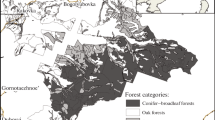Abstract
Floristic composition, diversity, dominance and distribution pattern of species and tree population structure were studied in three stands of a sub-tropical wet hill broad-leaved forest of Meghalaya, India, along a disturbance gradient. Tree species diversity declined with increasing disturbance. Disturbed stands showed low equitability or high dominance and the undisturbed stand exhibited high equitability or low dominance. Contagious distribution among the tree species increased with increasing intensity of disturbance. Species showing regular distribution were restricted only to the undisturbed stand. Effect of disturbance on tree population structure was analysed using density-diameter curves. In the disturbed stands tree species showed reverse J-shaped and/or negative exponential curves, while those in the undisturbed stand exhibited sigmoid to bimodal mound shaped curves.
Similar content being viewed by others
References
Armesto J. J. & Pickett S. T. A. 1985. Experiments on disturbance in old-field plant communities: Impact on species richness and abundance. Ecol. 66: 230–240.
Benton A. H. & WernerJr. W. E. 1976. Field Biology and Ecology. McGraw-Hill, New York. 564 pp.
Champion, H. G. & Seth, S. K. 1968. A revised survey of the forest types of India. Govt. India Publ., Delhi 251–267 pp.
Clements F. E. 1936. Nature and structure of the climax. J. Ecol. 24: 252–284.
Connell J. H. 1978. Diversity in tropical rain-forests and coral reefs. Sci. 199: 1302–1310.
Goff F. G. & West D. C. 1975. Canopy-understorey interaction effects on forest population structure. Forest Sci. 21: 98–108.
Grime J. P. 1979. Plant strategies and vegetation processes. J. Wiley, New York, USA.
Grubb P. J. 1977. The maintenance of species-richness in plant communities: the importance of the regeneration niche. Biol. Rev. 52: 107–145.
Huston M. 1979. A general hypothesis of species diversity. Am. Nat. 113: 81–101.
Kanzaki Mamoru & Kyojiyoda 1986. Regeneration in subalpine coniferous forests: Mortality and the pattern of death of canopy trees. Bot. Mag. Tokyo 99 (1053): 37–52.
Khan M. L., Rai J. P. N. & Tripathi R. S. 1986. Regeneration and survival of tree seedlings and sprouts in tropical deciduous and sub-tropical forests of Meghalaya, India. For. Ecol. Manage. 14: 293–304.
Khan M. L., Rai J. P. N. & Tripathi R. S. 1987. Population structure of some tree species in disturbed and protected sub-tropical forests of north-east India. Acta Oecologia/Oecol. Applic. 8: 247–255.
Knuchel H. 1953. Planning and control in the managed forest. Oliver and Boyd, Edinburgh. 360 pp.
Loucks O. L., Ek A. R., Johnson W. C. & Monserud R. A. 1980. Growth, aging and succession. In: D. E. Reichle (Editor), Dynamic properties of Forest Ecosystem. International Biological Programme 23, Cambridge University Press, Malta, pp. 37–85.
Lubcheno J. 1978. Plant species diversity in a marine intertidal community: importance of herbivore food preference and algal competitive abilities. Am. Nat. 112: 23–39.
Misra R. 1968. Ecology work book. Oxford & IBH. Calcutta. Newton, P. F. & Smith, V. G. 1988. Diameter distributional trends within mixed Black-spruce/Balsam-fir and pure Black spruce stand types. For. Ecol. Manage. 25: 123–138.
Paine R. T. 1966. Food web complexity and species diversity. Am. Nat. 100: 65–75.
Pandey A. N. & Singh J. S. 1985. Mechanism of ecosystem recovery: A case study from Kumaun Himalaya. Recreation and Revegetation Research 3: 271–292.
Pielou E. C. 1966. The measurement of diversity in different types of biological collections. J. Theoret. Biol. 13: 131–144.
Saxena A. K., Singh S. P. & Singh J. S. 1984. Population structure of forests of Kumaun Himalaya: implictions for management. J. Environ. Manage. 19: 307–324.
Schmeiz D. A. & Lindsey A. A. 1965. Size-class structure of old-growth forests in Indiana. For. Sci. 11: 258–264.
Sørensen T. 1948. A method of establishing groups of equal amplitude in plant sociology based on similarity of species content. Det. Kong. Danske Vidensk, Selsk Biology Skr (Copenhagen) 5: 1–34.
UNESCO/UNEP/FAO 1978. Tropical forest ecosystems: A state-of-knowledge report. Paris: UNESCO.
Vogl R. J. 1980. The ecological factors that produce perturbation-dependent ecosystems. In: J. Cairns (Editor), Recovery process in damaged ecosystems. Ann. Arbor Science Publishers, Ann. Arbor, Michigan, USA, pp. 63–94.
West D. C., ShugartJr. H. H. & Ranney J. W. 1981. Population structure of forest over a large area. For. Sci. 27: 701–710.
White P. S. 1979. Pattern, process and natural disturbance in vegetation. Bot. Rev. 45: 229–299.
Author information
Authors and Affiliations
Rights and permissions
About this article
Cite this article
Rao, P., Barik, S.K., Pandey, H.N. et al. Community composition and tree population structure in a sub-tropical broad-leaved forest along a disturbance gradient. Vegetatio 88, 151–162 (1990). https://doi.org/10.1007/BF00044832
Accepted:
Issue Date:
DOI: https://doi.org/10.1007/BF00044832




